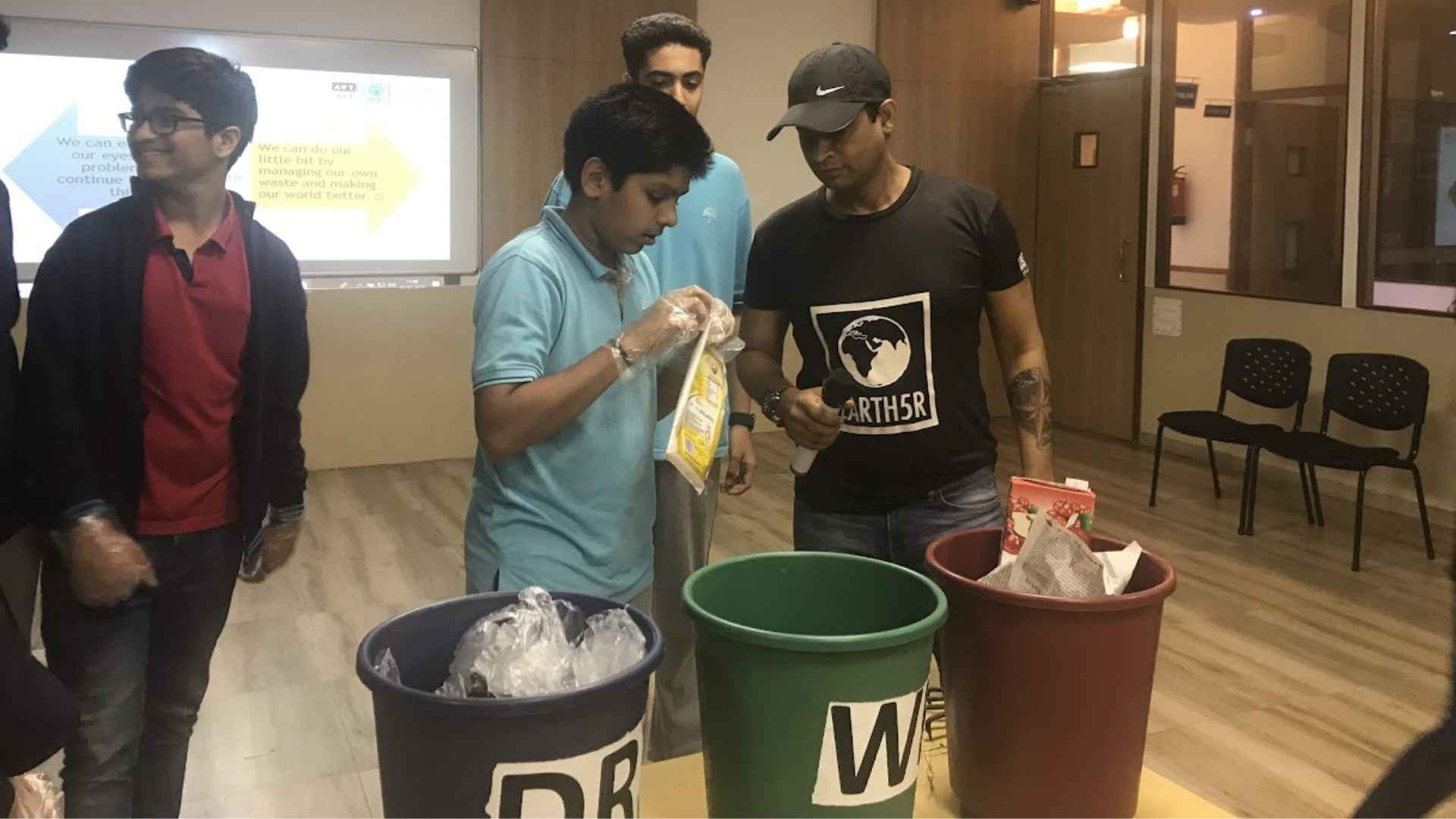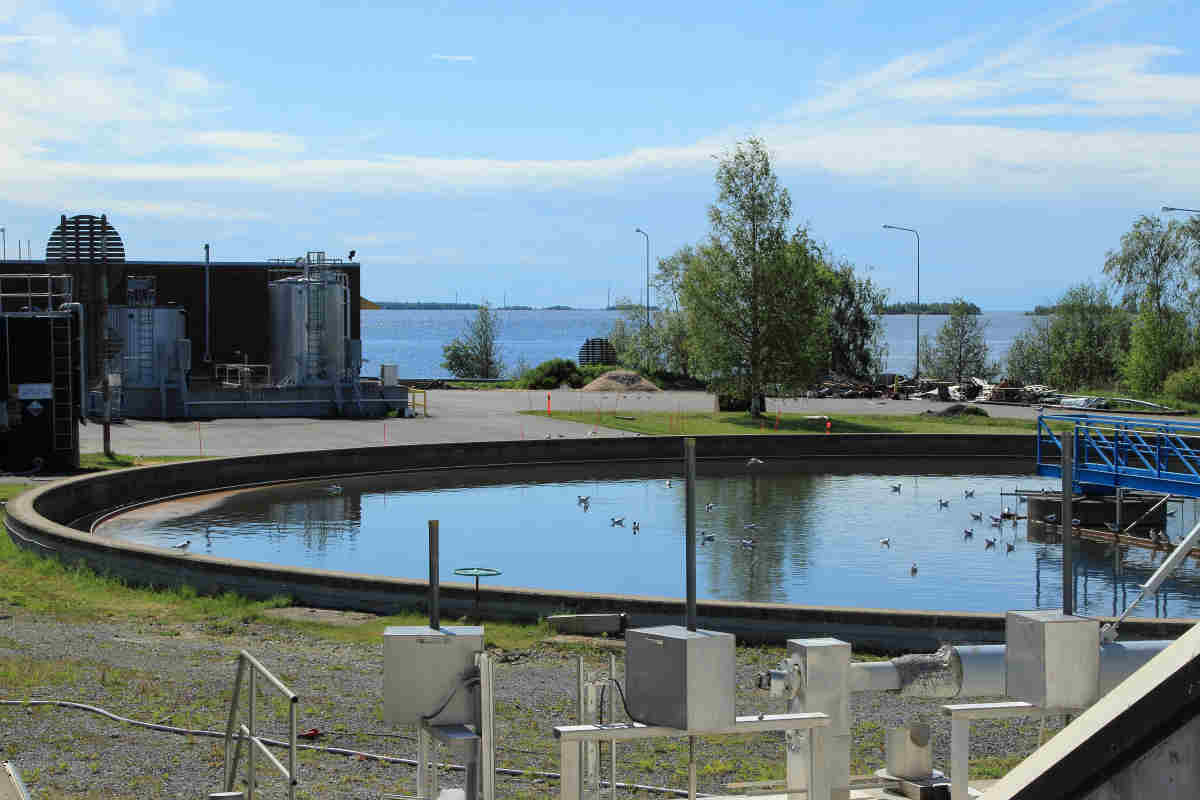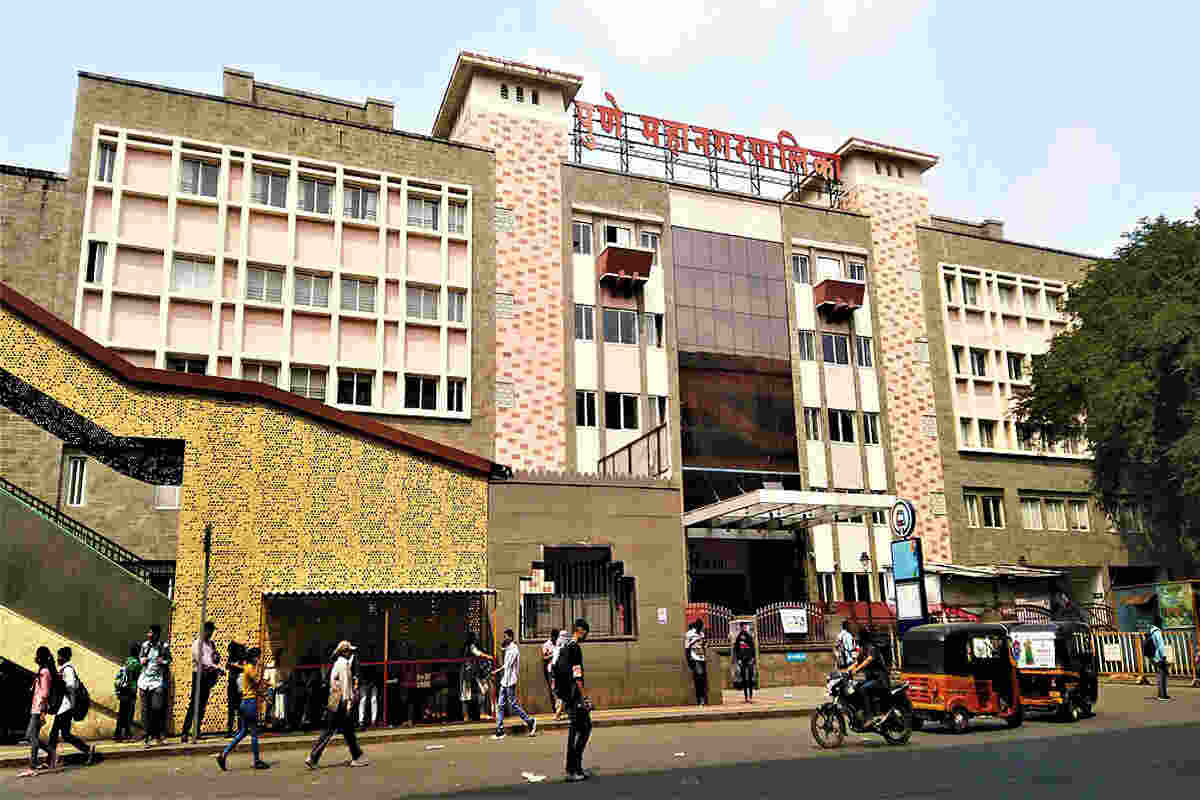As the world urbanizes at an unprecedented rate, cities are rapidly becoming the epicenters of economic activity, population growth, and, consequently, waste generation. According to the World Bank, urban areas generate over 2 billion tonnes of solid waste annually, a figure projected to rise to 3.4 billion tonnes by 2050. India alone produces more than 160,000 tonnes of municipal solid waste every day, with urban centers contributing the bulk.
In this context, conventional waste management systems—plagued by inefficiency, underfunding, and poor segregation practices—are increasingly inadequate. The growing waste burden poses serious environmental and public health risks, highlighting an urgent need for sustainable and scalable solutions.
Enter the concept of smart cities: urban ecosystems that integrate information and communication technologies to improve operational efficiency, share information with the public, and provide a better quality of government services and citizen welfare. Within this framework, waste management is a critical component—emphasizing data-driven decision-making, decentralization, and citizen engagement.
Earth5R, a Mumbai-based environmental organization, stands at the forefront of this shift. Through its community-driven, tech-enabled solid waste management system, Earth5R bridges grassroots participation with sustainable development principles. This article explores how Earth5R’s model not only addresses immediate waste management needs but also offers a replicable blueprint for smart cities worldwide.
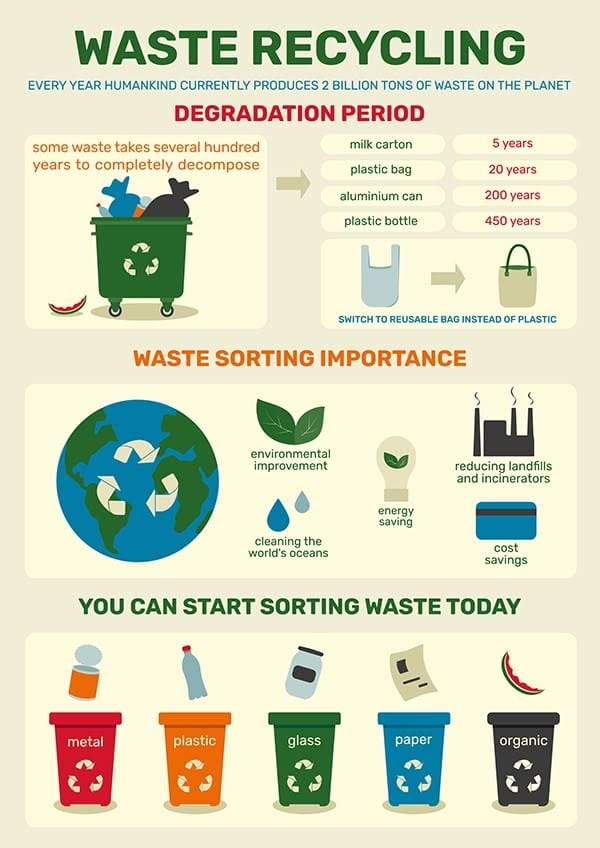
This infographic highlights the critical importance of waste recycling by showing how long common items take to decompose and the benefits of proper waste sorting. It emphasizes environmental improvement, energy savings, and cost reduction, while encouraging individuals to start segregating waste into categories like metal, plastic, glass, paper, and organic.
The Waste Crisis in Urban India and the World
The world is grappling with a solid waste crisis that grows more acute each year. According to the World Bank’s What a Waste 2.0 report, global municipal solid waste (MSW) generation stood at approximately 2.01 billion tonnes in 2016, with at least 33% of it not managed in an environmentally safe manner.
Projections suggest that by 2050, this number will increase by 70%, reaching 3.4 billion tonnes annually, driven by rapid urbanization, population growth, and increased consumption. Developing countries, particularly those in Asia and Sub-Saharan Africa, will bear the brunt of this surge. India reflects this global trend acutely. The Central Pollution Control Board (CPCB) reports that Indian cities generate around 160,000 tonnes of MSW daily, but only about 25% of this waste is processed scientifically.
The rest is dumped in open landfills or poorly managed dumpsites, leading to significant environmental degradation. Unsegregated waste releases methane—a potent greenhouse gas—contributes to groundwater pollution through leachate, and clogs urban drainage systems, exacerbating flood risks.
The health implications are severe. Studies published in journals like The Lancet and Environmental Research link mismanaged urban waste to respiratory illnesses, vector-borne diseases, and long-term exposure to carcinogens. Populations near landfills, particularly informal waste workers, face disproportionate health burdens due to lack of protective measures and formal recognition.
Despite government interventions like the Solid Waste Management Rules 2016 and the Swachh Bharat Mission, many municipal bodies struggle with outdated infrastructure, inadequate funding, and limited public awareness. Waste collection systems remain largely centralized, with little emphasis on segregation, composting, or recycling at the source.
The disconnect between policy and ground-level implementation has resulted in fragmented and often ineffective outcomes. Addressing this crisis requires not just technological fixes, but systemic, community-integrated models that promote sustainability and resilience—precisely the gap Earth5R aims to bridge.
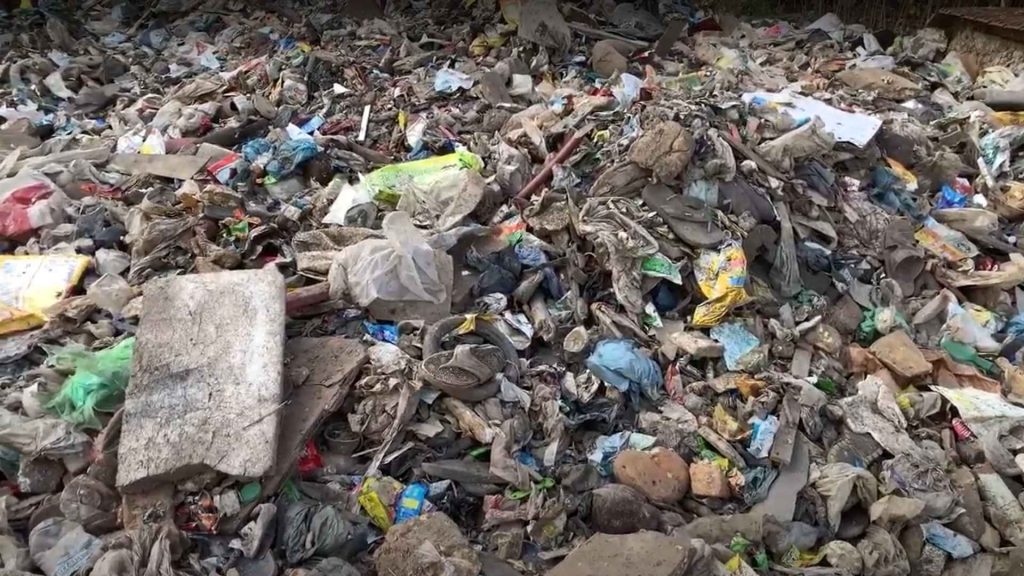
Earth5R’s Solid Waste Management Model
Earth5R’s solid waste management (SWM) system represents a holistic, community-centered approach to urban waste challenges. Designed to be scalable and adaptable across varied urban contexts, the model draws on scientific research, sustainability frameworks, and participatory governance principles. It addresses systemic shortcomings in traditional municipal waste systems by mobilizing communities, decentralizing waste processing, creating livelihoods, and embedding circular economy practices into local ecosystems.
Core Components of the Earth5R Model
Community Participation
At the heart of Earth5R’s strategy lies active citizen engagement. The model is rooted in the understanding that sustainable change is most effective when driven by communities themselves. Earth5R initiates extensive awareness campaigns and education programs that train residents in waste segregation, composting, and recycling. These efforts are informed by behavioral science research.
Studies show that environmental action becomes habitual when individuals understand its direct impact on their surroundings and feel empowered to contribute. Earth5R’s “One Minute Citizen” program, for example, leverages the power of micro-volunteering—encouraging individuals to contribute small, daily acts toward sustainable waste management. This behavioral nudge approach is backed by studies in environmental psychology that suggest frequent, low-effort engagement increases long-term commitment to sustainable practices.
Circular Economy Practices
Earth5R adopts a circular economy lens, shifting from a linear “take-make-dispose” model to one that emphasizes reuse, recycling, and resource recovery. The model promotes material cycles where waste is not an endpoint but a resource. Segregated waste is routed for composting (organic fraction), recycling (plastics, metals, paper), or upcycling (creative reuse), thereby reducing landfill burden and resource extraction.
This approach aligns with findings from the Ellen MacArthur Foundation and UN Environment Programme, which stress that circular economy strategies can reduce global waste by up to 90% in some sectors. Earth5R’s on-ground programs make this abstract ideal tangible in neighborhoods and informal settlements.
Decentralized Waste Processing
Unlike centralized municipal systems that rely on distant landfills or waste-to-energy plants, Earth5R’s model emphasizes localized waste management hubs. These micro-facilities—sometimes as simple as community compost pits or small-scale segregation centers—reduce transport costs, lower emissions, and enhance efficiency.
Decentralization also creates visibility, allowing communities to witness waste transformation in real-time. This visibility has been found in urban development studies to enhance public trust and participation in environmental systems. Additionally, decentralized systems offer redundancy, making urban waste systems more resilient to shocks such as floods or infrastructural failures.
Livelihood Generation
Earth5R integrates waste management with inclusive economic development by creating green jobs. It provides training to informal waste workers, women, and youth in segregation techniques, composting, and entrepreneurial skills. These trained individuals are then absorbed into local waste processing units or start their own micro-enterprises, such as producing organic compost or recycled products.
This employment dimension is crucial in cities where waste work is often informal, unsafe, and stigmatized. By formalizing and upskilling this labor, Earth5R addresses both social justice and environmental goals. Studies from the International Labour Organization and UN-Habitat affirm that sustainable waste systems must consider socioeconomic integration to succeed.
Scientific Principles Behind the Model
Earth5R’s methodology is grounded in interdisciplinary research spanning sustainability science, behavioral economics, and environmental governance. One of the key components is behavioral nudging, a concept popularized by Thaler and Sunstein (2008), which demonstrates that simple, low-effort interventions—such as reminder signage and clear, simplified instructions—can significantly enhance waste segregation behavior among citizens.
The model also adopts a systems thinking approach, recognizing that solid waste is not an isolated issue but is deeply interconnected with broader urban challenges, including public health, livelihoods, water quality, and air pollution. This perspective, advocated by institutions like the Stockholm Resilience Centre and UNEP, is vital for designing holistic urban sustainability solutions.
Furthermore, Earth5R incorporates resilience-building principles by decentralizing waste processes, empowering local communities, and creating responsive feedback loops. These strategies resonate with the Rockefeller Foundation’s 100 Resilient Cities framework, which emphasizes the importance of adaptability, inclusivity, and local ownership in strengthening urban systems against environmental and infrastructural shocks.
Case Studies and Success Stories
Mumbai (Powai Lake Community Cleanup & SWM)
Earth5R initiated a community waste management and cleanup project near Powai Lake in Mumbai—a critical urban waterbody suffering from plastic pollution and dumping. The project trained over 500 local residents and waste workers in waste segregation and composting. Waste collection centers were established at the neighborhood level, and recyclables were redirected to certified processors.
Within six months, waste dumping around the lake reduced by 65%, and over 15 tonnes of plastic waste were diverted from landfills. A post-intervention environmental impact assessment, conducted with local colleges, recorded improved water quality metrics and lower coliform levels in the lake.
Pune (Community Composting Units)
In Pune’s urban slums, Earth5R collaborated with local NGOs and RWAs (Resident Welfare Associations) to install small-scale composting units. These were operated by women trained through Earth5R’s green jobs program. Each unit processes 50–100 kg of organic waste daily, producing compost for urban farms and home gardens.
Apart from reducing municipal load, this project created a sustainable income source for over 20 women, aligning with SDG 5 (gender equality) and SDG 11 (sustainable cities). A follow-up study found a 40% increase in community awareness of composting and environmental hygiene.
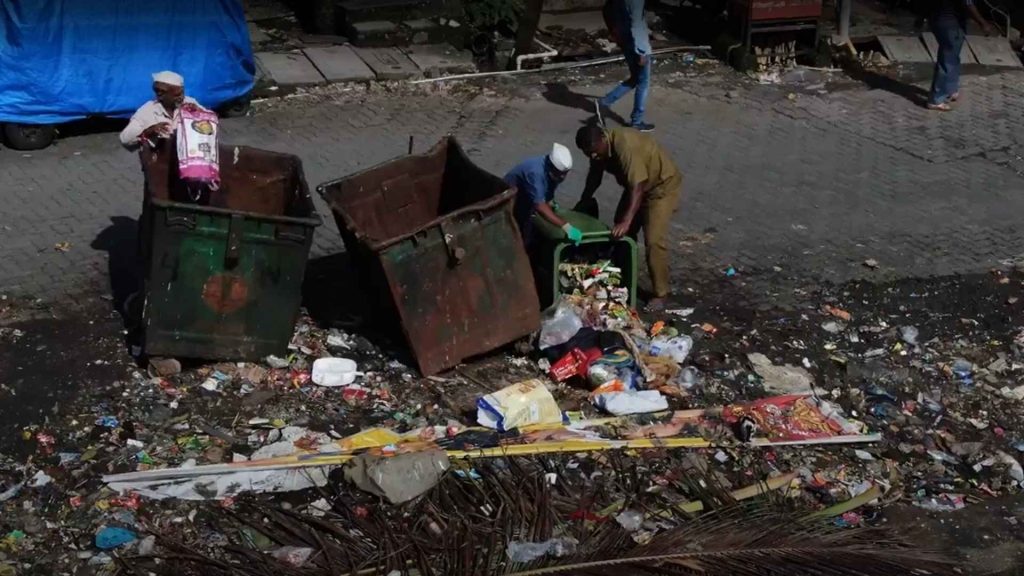
Integration with Smart City Frameworks
Earth5R’s solid waste management model aligns seamlessly with the vision and operational frameworks of smart cities, which emphasize sustainability, technology integration, and citizen-centric governance. At the core of Earth5R’s approach is the strategic use of digital tools and real-time data to enhance the efficiency and transparency of waste management processes, making it an ideal fit for smart city ecosystems.
Technological Integration
Earth5R leverages mobile technology and digital platforms to foster engagement, monitor waste flows, and map environmental impact. The organization’s flagship mobile app enables citizens to report waste hotspots, access segregation guidelines, and participate in clean-up drives.
These real-time data inputs are aggregated and analyzed to generate AI-driven waste maps, which help identify areas with high waste accumulation and inform targeted interventions. This data-driven decision-making improves operational responsiveness, optimizes resource allocation, and supports predictive maintenance of waste infrastructure—hallmarks of smart urban governance.
Moreover, Earth5R’s community dashboards allow for transparent data visualization, displaying metrics like waste diverted from landfills, compost generated, and emissions avoided. This fosters accountability and encourages sustained citizen participation—key components of a smart city’s participatory governance model.
Alignment with Smart City Indicators and SDGs
Earth5R’s model supports several key indicators within the Indian Smart Cities Mission, particularly under themes such as urban environment, sanitation, and ICT-enabled services. By embedding sustainability into its core operations, Earth5R also makes significant contributions to the United Nations Sustainable Development Goals (SDGs).
Specifically, it advances SDG 11 (Sustainable Cities and Communities) through its localized waste management solutions and strong focus on community engagement. Its emphasis on reuse, recycling, and material recovery aligns with SDG 12 (Responsible Consumption and Production) by promoting circular economy practices that reduce the overall environmental footprint of urban consumption.
Additionally, by diverting organic waste from landfills, Earth5R helps reduce the volume of waste that contributes to harmful emissions. The organization actively promotes composting and recycling as sustainable alternatives to conventional waste disposal.
These practices play a critical role in achieving SDG 13 (Climate Action) by mitigating methane emissions, a potent greenhouse gas. Collectively, these efforts demonstrate that smart cities must go beyond technological advancement to embrace environmental responsibility and social inclusivity—principles that are deeply embedded in Earth5R’s mission.
Policy Alignment
Earth5R’s initiatives are also well-aligned with India’s national policy frameworks. The Swachh Bharat Mission (Urban), a flagship sanitation program, emphasizes behavior change, citizen engagement, and decentralized waste solutions—all of which are central to Earth5R’s methodology. Similarly, the Solid Waste Management Rules 2016 advocate for source segregation, decentralized processing, and the integration of informal waste workers.
These are practices that Earth5R has effectively operationalized across multiple cities. The organization combines grassroots innovation with smart technologies and aligns closely with existing policy frameworks. As a result, Earth5R exemplifies a scalable and inclusive model for sustainable urban waste management that aligns with the evolving priorities of smart city development.
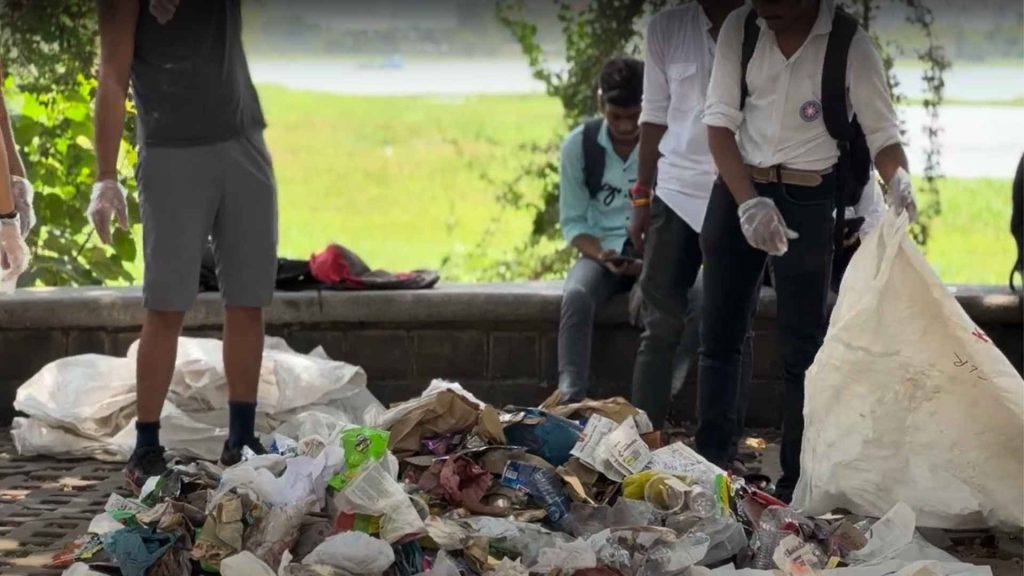
Scalability and Replicability
Earth5R’s solid waste management model is designed with scalability at its core. A key enabler of this scalability is community ownership. By placing local residents at the center of waste management efforts—through training, capacity-building, and engagement programs—Earth5R creates systems that are sustained by the very people they serve. This bottom-up approach minimizes dependence on centralized infrastructure and government intervention, allowing the model to be adapted across urban, semi-urban, and even rural contexts.
The use of low-cost, accessible technology further enhances replicability. Earth5R leverages smartphones, mobile applications, and simple waste mapping tools to facilitate real-time data collection, citizen participation, and monitoring. These tech solutions are intentionally lightweight and affordable, ensuring that the model can function even in resource-constrained environments. In addition, Earth5R’s modular design allows components like composting units, segregation centers, and training modules to be added or removed based on local needs.
This flexibility makes the model highly adaptable across different scales and geographies. Despite these strengths, scalability does face challenges. Policy ambiguity, limited funding, and low public awareness are common barriers in urban waste management. Earth5R tackles these by working directly with municipal bodies to align their model with existing policies such as the Solid Waste Management Rules 2016 and the Smart Cities Mission.
To address funding constraints, the organization often partners with CSR programs, local businesses, and international development agencies. Awareness and behavioral inertia are countered through consistent educational outreach and behavior-change campaigns that draw from behavioral economics and environmental psychology.
A comparative lens shows Earth5R’s distinctiveness. For example, Curitiba, Brazil is renowned for its integrated public transportation and waste recycling exchange programs. While successful, Curitiba’s model is heavily dependent on government infrastructure and incentives.
Sweden’s national recycling system, on the other hand, benefits from strong institutional frameworks and high-tech sorting facilities, but it is capital intensive and less community-driven. In contrast, Earth5R’s model operates at the intersection of low-cost innovation, grassroots participation, and decentralization, making it particularly suitable for developing countries and rapidly urbanizing regions.
Thus, Earth5R demonstrates that effective and scalable solid waste management does not require massive infrastructure or centralized systems—it requires community trust, smart design, and the will to act locally for global impact.
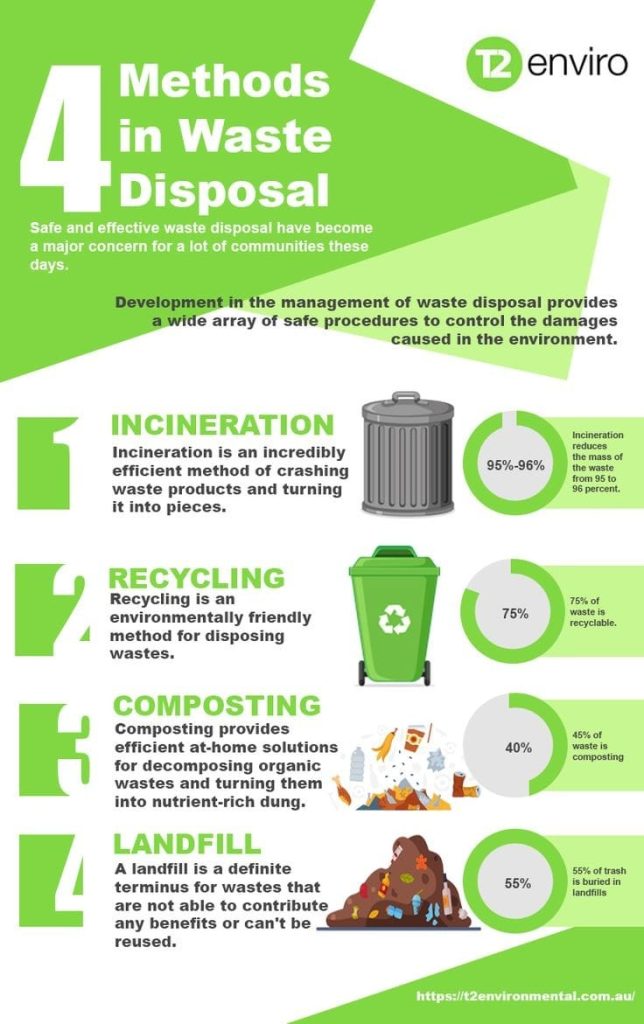
This infographic outlines four primary waste disposal methods—incineration, recycling, composting, and landfill—highlighting their efficiency and environmental impact. It emphasizes the importance of sustainable practices, showing that 75% of waste can be recycled and 40% composted, reducing reliance on landfills.
Research & Scientific Evidence Supporting Earth5R’s Approach
Earth5R’s solid waste management model is underpinned by a growing body of scientific evidence that validates its environmental, economic, and behavioral impacts. Multiple impact assessment studies conducted in collaboration with academic institutions and independent researchers highlight the tangible outcomes of Earth5R’s interventions.
For instance, a field study conducted in partnership with students from IIT Bombay and local NGOs in Mumbai showed significant results. In areas where Earth5R implemented community-led waste segregation and composting programs, there was a 50–60% reduction in mixed waste sent to landfills within six months. Similar assessments were carried out in Pune.
These studies recorded a consistent improvement in waste handling practices and a measurable drop in household waste generation, largely attributed to increased awareness and behavior change. From an environmental modeling perspective, Earth5R’s initiatives have contributed significantly to reducing greenhouse gas emissions.
By diverting organic waste from landfills and processing it through composting, the organization minimizes methane emissions—a greenhouse gas 25 times more potent than carbon dioxide over a 100-year period. A lifecycle assessment (LCA) model applied to Earth5R’s Pune community composting units estimated an annual reduction of over 20 metric tonnes of CO₂-equivalent emissions per ward.
Besides, by promoting recycling and reuse, Earth5R reduces the need for raw material extraction and energy-intensive manufacturing processes, further cutting carbon footprints. Economically, Earth5R’s model demonstrates cost savings for municipal bodies. Decentralized waste processing reduces transportation costs, landfill maintenance expenses, and environmental cleanup liabilities.
Moreover, the model fosters green entrepreneurship—individuals trained by Earth5R have launched micro-enterprises centered around recycled products, compost sales, and waste audits, thereby generating local employment and economic value. This aligns with research by the International Solid Waste Association (ISWA), which emphasizes the economic advantages of decentralized, circular waste systems.
Behavioral science also plays a crucial role in Earth5R’s strategy. The organization applies principles from nudge theory, social norm modeling, and environmental psychology to influence citizen behavior. Visual cues, community champions, and gamification have been effectively used to promote source segregation and reduce littering.
These interventions are supported by global research, including studies published in Nature Sustainability and the Journal of Environmental Psychology. The findings affirm that consistent, low-barrier engagement significantly increases compliance with sustainable waste practices.
Together, this interdisciplinary evidence base affirms that Earth5R’s approach is not only innovative and community-driven but also scientifically sound, environmentally impactful, and economically viable for scaling across diverse urban contexts.
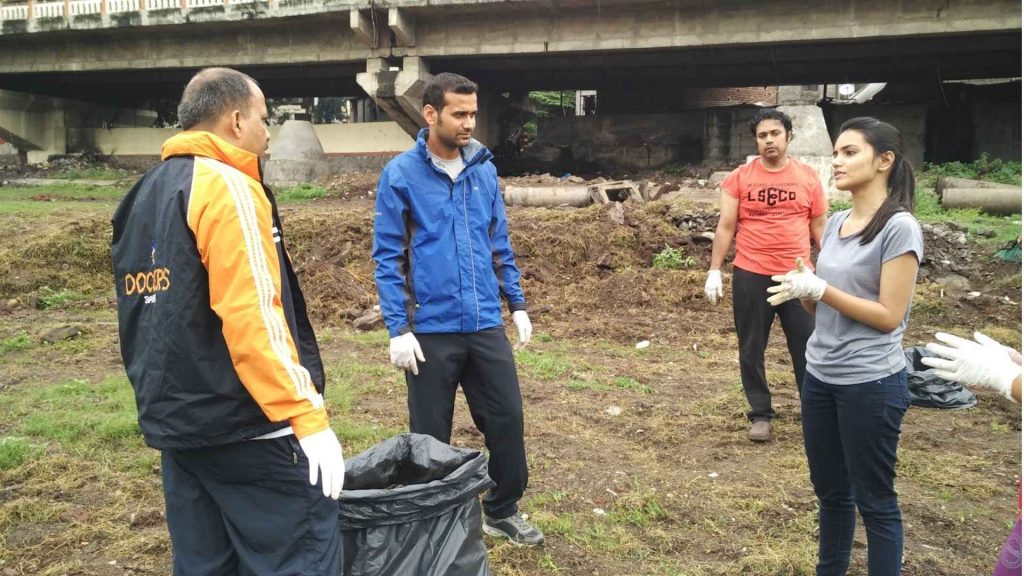
Earth5R’s Scalable Waste Solution: A Community-Driven Blueprint for Smart and Sustainable Cities
The growing crisis of urban solid waste presents one of the most pressing environmental and governance challenges of our time, especially in rapidly urbanizing countries like India. As cities expand, so does the complexity and volume of waste generated—placing immense strain on existing municipal systems.
Earth5R’s scalable solid waste management model offers a transformative, science-backed solution to this problem by integrating community action, technology, and sustainability into a unified framework. Unlike conventional, centralized waste systems, Earth5R’s approach decentralizes waste management by empowering communities, fostering circular economy practices, and promoting livelihood generation.
This participatory model not only addresses the technical aspects of waste collection and processing but also strengthens environmental awareness and behavioral change at the grassroots level. The model’s use of digital tools, real-time data mapping, and mobile apps demonstrates how low-cost technology can be effectively leveraged to drive smart and sustainable urban development.
Scientific studies and impact assessments validate Earth5R’s outcomes, from significant reductions in landfill-bound waste and greenhouse gas emissions to economic benefits for local communities. The model aligns with global and national policy frameworks such as the United Nations Sustainable Development Goals, the Smart Cities Mission, and the Solid Waste Management Rules 2016—positioning it as both globally relevant and locally adaptable.
Furthermore, when compared to other international waste management systems, Earth5R stands out for its inclusive, bottom-up methodology that combines innovation with accessibility. Its scalability is made possible by its modular design, behavioral insights, and stakeholder-driven governance, making it a replicable model not only across Indian cities but also in other developing regions.
In essence, Earth5R’s solid waste management system exemplifies how community-driven solutions, grounded in science and supported by smart governance, can chart the path toward more sustainable, resilient, and inclusive cities. It is not just a waste solution—it is a blueprint for systemic urban transformation.
FAQs on Earth5R’s Scalable Solid Waste Management System for Smart Cities
What is Earth5R’s solid waste management system?
Earth5R’s system is a decentralized, community-driven waste management model that integrates sustainability, technology, and social inclusion to reduce landfill waste and promote recycling, composting, and circular economy practices.
Why is solid waste management important in smart cities?
Efficient waste management ensures cleaner environments, better public health, and sustainable urban development—key objectives of smart city frameworks.
What makes Earth5R’s model scalable?
Its modular design, low-cost technology, community ownership, and adaptability to different urban contexts make it scalable across cities and regions.
How does Earth5R incorporate technology in its model?
Earth5R uses mobile apps, real-time data tracking, AI-based waste mapping, and digital dashboards to monitor waste flow and promote citizen participation.
How does Earth5R align with the concept of a smart city?
Earth5R supports smart city goals by improving sanitation, leveraging ICT tools, promoting sustainability, and involving citizens in governance.
What scientific evidence supports Earth5R’s approach?
Studies in Mumbai and Pune show a 50–60% reduction in landfill waste. Environmental modeling highlights reduced methane emissions and carbon footprints.
How does Earth5R reduce greenhouse gas emissions?
By diverting organic waste from landfills and promoting composting, the model cuts methane emissions, a potent greenhouse gas.
What role does behavioral science play in Earth5R’s model?
Earth5R uses nudges, social norms, and visual cues to encourage source segregation and sustainable practices.
Is Earth5R’s model environmentally sustainable?
Yes, it promotes waste reduction, recycling, composting, and reduced reliance on landfills—key pillars of environmental sustainability.
How does Earth5R support circular economy principles?
By turning waste into resources, encouraging reuse, and creating local green livelihoods, Earth5R reinforces circular economy values.
Does Earth5R work with local governments?
Yes, it collaborates with municipal bodies and aligns with policies like the Swachh Bharat Mission and the Solid Waste Management Rules 2016.
How does Earth5R address policy and funding barriers?
Through CSR partnerships, public-private collaborations, and community-led implementation that reduces dependency on centralized funding.
Is Earth5R’s system compliant with Indian waste management laws?
Yes, it fully supports the Solid Waste Management Rules 2016, including source segregation, decentralized processing, and informal sector inclusion.
Can Earth5R’s model be implemented in rural or semi-urban areas?
Yes, its flexible, modular design allows it to be adapted to various scales and contexts, including rural settings.
How does Earth5R train communities?
Through workshops, on-ground training, mobile learning modules, and partnerships with local NGOs and educational institutions.
How does Earth5R’s model differ from Sweden’s recycling system?
While Sweden relies on centralized, high-tech infrastructure, Earth5R uses decentralized, community-driven, low-cost methods suitable for the Global South.
How does it compare with Curitiba’s model in Brazil?
Curitiba depends on government-led exchanges and infrastructure, whereas Earth5R emphasizes community ownership and localized solutions.
Can Earth5R’s model be replicated globally?
Yes, especially in developing countries or urban areas struggling with infrastructure limitations, waste mismanagement, and social exclusion.
What are the social benefits of Earth5R’s waste management system?
It creates green jobs, includes informal waste workers, and builds awareness—fostering environmental stewardship and community empowerment.
What are the economic benefits of Earth5R’s model?
It reduces municipal costs on transport and landfill management while generating livelihoods through compost sales, recycling, and waste entrepreneurship.
Be the Change: Join the Movement for Cleaner, Smarter Cities with Earth5R
Urban areas across the globe are facing a growing waste crisis, threatening public health, the environment, and long-term sustainability. Earth5R’s scalable, community-driven solid waste management model presents a powerful, proven solution that integrates local action, low-cost technology, and sustainable practices to transform how cities handle waste.
Now is the time to act. Whether you’re a citizen, policymaker, corporate leader, or researcher, there’s a role for you in building sustainable cities. Citizens can begin with simple yet powerful actions like segregating waste at the source, composting kitchen waste, and mobilizing their communities. Policymakers and urban planners can integrate Earth5R’s model into city-wide waste management systems and smart city frameworks.
Corporates and CSR programs have the opportunity to support these efforts through partnerships that yield both social and environmental benefits. For researchers and students, Earth5R offers a living, scalable example of interdisciplinary sustainability in action. Together, we can reframe waste not as a problem but as an opportunity—for innovation, green livelihoods, and environmental renewal.
Join Earth5R and become part of the movement toward cleaner, smarter, and more resilient cities. The future of sustainable urban living begins with a single step—make yours count.
~Authored by Ameya Satam

